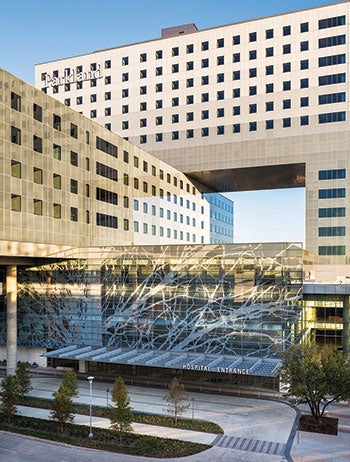Charitable giving up, helping to build hospitals
 |
| PHOTO © ANDREW POGUE/COURTESY OF HDR + CORGAN The broad-based campaign for the new Parkland hospital campus included contributions from more than 12,700 donors. |
Securing the capital needed to build a new or replacement hospital has been especially challenging for many health care organizations since the Great Recession. For publicly financed facilities, the proposition has been particularly tough.
The new $1.32 billion Parkland hospital campus in Dallas, however, has overcome all the normal obstacles and then some. When the new main hospital officially opens in August, it will be a landmark event — and not just because of its immense size and scope in serving more than 1 million patients a year in rapidly growing Dallas County.
Particularly noteworthy is the fact that the organization already has surpassed its charitable giving program goal from private sources of $150 million. The broad-based campaign included contributions from more than 12,700 donors, with gifts ranging from 50 cents to $50 million.
“The way the people of Dallas County came together to raise this money is an inspiration,” says David E. Krause, FAHP, president and CEO for Parkland Foundation, which began its fundraising campaign in 2008 — the same year that Dallas County approved a $747 million bond campaign to help build the new 2.8 million-square-foot campus.
The new main hospital includes 862 single-patient rooms with private bathrooms, and features same-handed room design. In addition, standardized sink locations are designed to enhance hand-hygiene compliance and contribute to the overall emphasis on improving patient safety throughout the facilities.
Funds raised through the “I Stand For Parkland” philanthropy campaign helped to finance the project. It also marked the largest philanthropy project the health system had ever undertaken, easily outdistancing a previous $14 million effort to support a $26 million ambulatory surgery center.
“That was sort of like training wheels,” according to Krause. “We knew we were going to be building a whole new Parkland [campus], so this was a very successful trial run.”
Around the country, more and more health care organizations are starting to think big when it comes to private fundraising to help fund capital projects and other endeavors.
Mount Sinai Health System in New York City, for instance, raised more than $1.5 billion in a successful capital fundraising campaign that ended in December 2013 — exceeding its goal by 50 percent.
In a charitable giving effort named “Rising to the Challenge: The Campaign for Johns Hopkins,” the renowned university and school of medicine hope to raise $4.5 billion by 2017. During the so-called “quiet phase” of the campaign in 2012, the organization raised $1.94 billion or 43 percent of the goal, including a $350 million donation from former New York City Mayor Michael Bloomberg. And, although this program was not centered on building projects, it underscores the impact that charitable giving programs can have on helping health care organizations to achieve their strategic objectives.
Thanks in large part to the stock market’s recovery since 2008, the climate is good for charitable giving in health care, notes Betsy Chapin Taylor, FAHP, president and principal consultant at Accordant Philanthropy, Ponte Vedra Beach, Fla. The group helps hospital and health system leaders to develop effective strategies for achieving their organizational fundraising goals.
“A lot of hospitals have been repositioning their philanthropy programs and looking at them less as a decorative social endeavor to seeing philanthropy more as a core revenue resource,” says Taylor.
In Parkland’s case, Krause says the focus was on building a public-private partnership.
“We’re not shying away from the fact that we’re publicly supported. We’re the safety net hospital. We’re taking care of the most vulnerable patients, and that’s what the community as a group decided to do with its tax dollars," according to Krause. "But, we need private money to enhance, improve and deliver excellent service through the facilities that we offer.”




